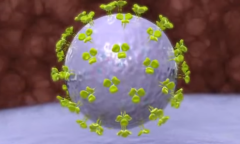By KM Diaz, | May 09, 2017

People with photosensitive epilepsy are known to be sensitive against flashing lights that could possibly trigger seizures. (YouTube)
People with photosensitive epilepsy are known to be sensitive against flashing lights that could possibly trigger seizures. Now, a study published in Current Biology revealed that certain still images can also trigger seizures.
The answer, according to the study, is because of the particular constant pattern of neural activity in the brain called "gamma oscillations." This condition happens when people observe certain still images, like black and white bar designs, and not others. These image patterns are known to be responsible for other conditions, like migraines especially to those who are sensitive to light.
Like Us on Facebook
Dora Hermes from the University Medical Center (UMC) Utrecht in the Netherlands, suggest that when it comes to designing buildings, it is important to avoid types of visual patterns that could stimulate gamma oscillations. Healthy individuals may also experience moderate distress from these images and designs.
Gamma oscillations are measured using electroencephalogram (EEG), it estimates the electrical activity of the brain using small electrodes connected to the scalp.
Some scientists claim that these oscillations are essential and highly important for attention, awareness and neuronal communication, whereas others assume that they are byproducts of natural neuronal processing, such as the exhaust coming out of a car - a useful diagnostic signal, but not the one that does the neuronal engine work.
Another argument against the idea believes that gamma oscillations are necessary for neural processing, and that they are being created in the brain when observing some images and not others.
Hermes and her colleagues, including Dorothée Kasteleijn-Nolst Trenité from UMC Utrecht, and Jonathan Winawer from New York University, have concluded that gamma-oscillation-provoking images are likely to trigger seizures.
Winawer also said that they have noticed a connection between images that trigger normal brain activity and photosensitive epilepsy, which is particular to gamma oscillations, and not to other kinds or neuronal responses like the overall rate of action potentials.
The findings imply that existing investigations on gamma oscillations could provide significant evidence to understand photosensitive epilepsy. The researchers are now planning an additional study to explore the patterns of brain response in patients with photosensitive epilepsy and those without. They are also working on a pattern to predict which natural scenes or images are likely to prompt gamma oscillations and seizures.
-
Use of Coronavirus Pandemic Drones Raises Privacy Concerns: Drones Spread Fear, Local Officials Say

-
Coronavirus Hampers The Delivery Of Lockheed Martin F-35 Stealth Fighters For 2020

-
Instagram Speeds Up Plans to Add Account Memorialization Feature Due to COVID-19 Deaths

-
NASA: Perseverance Plans to Bring 'Mars Rock' to Earth in 2031

-
600 Dead And 3,000 In The Hospital as Iranians Believed Drinking High-Concentrations of Alcohol Can Cure The Coronavirus

-
600 Dead And 3,000 In The Hospital as Iranians Believed Drinking High-Concentrations of Alcohol Can Cure The Coronavirus

-
COVID-19: Doctors, Nurses Use Virtual Reality to Learn New Skills in Treating Coronavirus Patients













